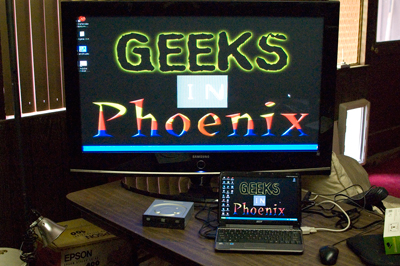In this article, I show a couple of uses for a second monitor connected to a netbook.

Connecting a second monitor to a Netbook is relatively easy. Getting the right aspect ratio, well, it depends on what type of monitor you use. Believe it or not, but I found using a 42" plasma TV the best.
3e745a7a-cb45-4ce2-8a57-f2a88df74478|0|.0|96d5b379-7e1d-4dac-a6ba-1e50db561b04
I little while back, I wrote an article on using Dual Monitors. In it, I wrote how a person with a visual impairment could use two monitors. Here's a snippet:
"This scenario also works well for those with visual impairments that require a magnification utility. You can use a larger monitor as the ‘main’ display and a smaller monitor as the ‘secondary’ display. Using the main display for all standard functions, the secondary display shows a magnified view of the main display. And without the need for matching monitors, you could pick up a cheap used one to run as secondary. Try your local Goodwill, Savers, thrift shop, etc."
Here's a video showing how to use dual monitors in Windows for users who have impaired vision.
6c9fc50b-5f17-45a8-868a-5bdd23b876db|0|.0|96d5b379-7e1d-4dac-a6ba-1e50db561b04
A little while back, I wrote an article on using Dual Monitors. Here's a snippet:
"With newer computers having the ability to run multiple displays, here is a ‘Geek Tip’ for those of you thinking about using two monitors on one computer. There are various scenarios, and I am going to describe just a few. I currently have two systems here with dual monitor setups."
Here's a video showing the two different computer scenarios I have that use dual monitors in Windows.
1417d7e3-d2be-41cc-b166-a61aed00b8b0|0|.0|96d5b379-7e1d-4dac-a6ba-1e50db561b04
With newer computers having the ability to run multiple displays, here is a ‘Geek Tip’ for those thinking about using two monitors on one computer. There are various scenarios; I am going to describe just a few. I currently have two systems here with dual monitor setups.
Of course, there is the side-by-side scenario, either horizontally or vertically, with the desktop expanded across the monitors. The first thing to consider is having two monitors precisely alike. It’s not necessary, but it is recommended. With this setup, you can work with a different program on each monitor. Makes copy and pasting a breeze. And you can also stretch a program across both monitors (left monitor has a work area; the right monitor has the tool palette).
This scenario also works well for those with visual impairments that require a magnification utility. You can use a larger monitor as the ‘main’ display and a smaller monitor as the ‘secondary’ display. Using the main display for all standard functions, the secondary display shows a magnified view of the main display. And without the need for matching monitors, you could pick up a cheap used one to run as secondary. Try your local Goodwill, Savers, thrift shop, etc.
Then there is what I like to call the back-to-back scenario, with the monitors on opposing faces of a wall or walls. The keyboard and mouse can be used wirelessly or through a USB cable. Yes, you can run more than one keyboard and mouse on a system, if this helps. In this case, cloning the display across both monitors is required, as the user can only view one monitor at a time.
With this scenario, you can have a presentation monitor (LCD or plasma TV works well) on one wall and a standard monitor at the workstation. The variations on these scenarios are vast, and I hope I have inspired you to look into using dual monitors.
870ed2a6-ad45-43d1-b47e-011f380d045b|0|.0|96d5b379-7e1d-4dac-a6ba-1e50db561b04